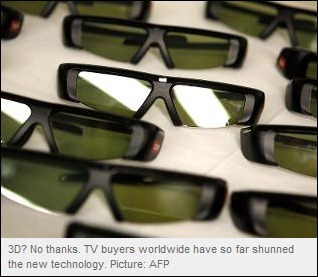3D TVs a 2010 Sales Dud

Based on data from DisplaySearch, The New York Times (NYT) is reporting a huge 17 percent increase in worldwide flat screen television sales compared to Christmas last year. The article points out that this would have been partially due to massive Christmas season discounting with some major brand televisions being discounted by 40 to 45 percent compared to prices just two months before Christmas.
On the downside sales of 3D TVs—which were supposed to be “the next big” thing this Christmas—just did not happen. Most retailers failed to even clear their remaining pre-Christmas stocks of 3D TVs. A company called DisplaySearch that tracks the popularity of TV technology trends and sales estimate that only 3.2 million 3D TVs were sold worldwide for the whole of 2010.
Compare that to the estimated 247 million non-3D TV units sold in 2010. So only about one tenth of one percent (0.013% to be precise) of TV sales in 2010 were 3D. To put it another way, in 2010 for every 3D TV sold there were 77 non-3D TVs sold.
Despite these hugely disappointing sales outcomes for 3D TV in 2010 the television industry is still pinning its hopes on 3D TV as the next big money maker. The view is that sales of 3D TVs will pick up in 2011 as the worldwide impact of the Global Financial Crisis fades to grey and people become more excited by the “super high-definition immersive experience that 3D TV provides” (their words, not mine).
My personal view is that I really don’t see 3D TV becoming that popular any time soon. My four key reasons for this are summarised below:
- I don’t see the impact of the Global Financial Crisis “fading to grey” in 2011. I think that the impact of the crisis on people’s earnings, jobs prospects, and spending habits is likely to last as long as five or more years yet. The world’s largest economy, the USA, is far from having shaken off the financial costs and impacts of the Global Financial Crisis.
- With current 3D TVs the viewing experience for non-3D content is degraded (compared to watching it on a non-3D TV) and we all have tons more non-3D TV to watch than we do 3D TV—and this is not likely to change for some time. Probably at least five years.
- For a good experience watching 3D TV you need to: (a) wear special glasses, (b) you need to be within about a 12 degree horizontal viewing vector directly in front of the TV, and (c) you have to be at the optimal distance from the TV (which depends on the size of the TV).
What a pain! For a typical 42” 3D TV to get the optimal 3D experience you need to be between 3.5 and 4.2 metres from the screen. I just checked my main viewing room and I can’t even get my chairs 3.5 metres back from the screen due to the room design.
- This last reason is a big one and is going to be the hardest one for the TV industry to overcome. By and large the upcoming generations, like anyone under about 25 now, are not that into high quality viewing (or listening). Us baby boomers and the generation that followed strive for quality sound and quality vision. We like things to be crisp and clear. When we ‘rip’ a CD we rip it at 320bps and don’t care that the MP3 files produced are 6MB in size. We hate having grey-ish whites and white-ish blacks.
But the under-25s could care less about high fidelity sound and viewing. When they pick a tune off iTunes they pick the smallest one—the one ripped at 64bps that is 1.5MB in size because it downloads faster. They are happy to watch massively compressed 480y 15fps or less YouTube streaming videos for hours with no complaint. They are happy to watch BitTorrent downloaded movies with up to 65 percent compression downsized from 1080y to 640y and with out-of-sync sound on their PCs or Xbox screens.
So, you have to ask yourself then, why would these people even bother with the “super high-definition immersive experience that 3D TV provides?”

